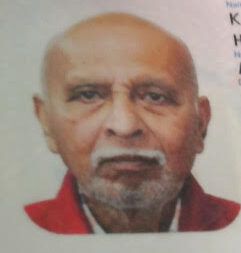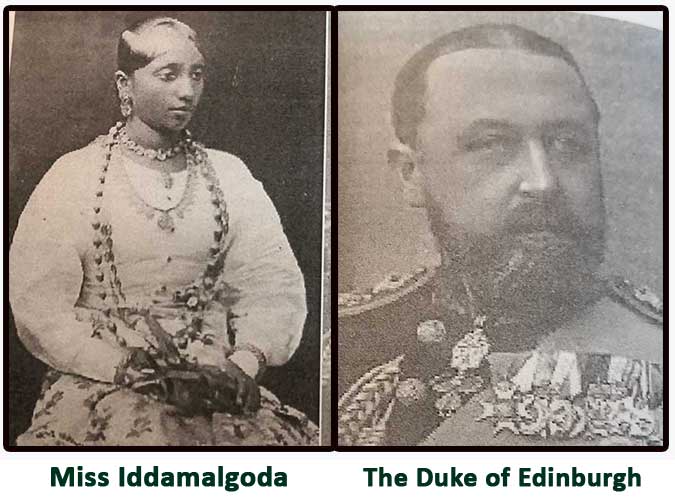The Duke of Edinburgh and the Sinhalese beauty- by Hugh Karunanayake
Source:Island
Much has been written about the visit of Prince Alfred, the second son of Queen Victoria, the reigning monarch of the far flung British Empire, and his visit to Ceylon in 1870. Prince Alfred was 26 years of age at the time. In that day and age, a visit from a member of the British royal Family was something unusual and extraordinary. It was the age where “the sun never set on the British Empire”, whose monarch had supreme rights over the lives of the millions of her subjects.
The impending visit by Prince Alfred to India and Ceylon among other countries of the British Empire had caused tremendous excitement, and plans were afoot many months in advance, to entertain the Prince in right royal fashion. The Governor of Ceylon at the time was Sir Hercules Robinson, formerly the Governor of New South Wales in Australia. He together with the tens of thousands of British families living in the island at the time, were determined to make the Prince’s visit a memorable one. Several books have been written on the Prince’s tour, and among these was John Capper’s book devoted exclusively to the prince’s tour of Ceylon, titled: The Duke of Edinburgh in Ceylon- a book of elephant and elk sport- London 1871.
The Duke’s five week tour of the island from March 30 to May 6, 1870 were marked by levees hosted by the Governor in Colombo, receptions by the British planters in Kandy, the reception by the De Soysa family in Colombo, and several excursions into the jungles of the country for elephant and elk shooting. The reception by the De Soysa family in Alfred House (named after the Prince) has been well documented, famous for its lavish entertainment, opulence, and grandeur where the duke and his party were served dinner in gold plates, and gem encrusted cutlery, the Prince leaving the party at 2 am in the morning.
Among the main items of “entertainment” for the royal visitor was the elephant kraal conducted in Labugama, only 30 miles from Colombo, but at that time, teeming with wild life, including many large herds of wild elephants. It was at the kraal that the Duke first met the young Sinhalese beauty who no doubt made a favourable impression on him. She was Miss Idulmalgodde, an 18 year old daughter of a Kandyan chieftain.
In Capper’s words ” The charming Miss Idulmalgodde, followed by her long retinue of serving men and maids, was borne slowly along in her palanquin”. In describing the young lady, Capper says:” Among the many visitors present at this kraal, and favoured with admission to the Royal stand, was a most interesting group, an aged Kandyan woman of the better class, the wife of Idulmalgodde, a chief of the Saffragam or Ratnapura district, and principal director of the kraal arrangements, who, with her daughter and female attendants and a punkah bearer, came to see the kraal somewhat, and the prince a good deal.
“Miss Idulmalgodde is a splendidly formed classical beauty, and an heiress into the bargain; she was just entering upon the ripening development of oriental eighteen, her limbs would have formed studies for a sculptor; her features would have charmed Correggio; her rich black glossy hair, dark as midnight, falling in clusters over her bare shoulders, and looped up here and there with threads of gold, studded with jewels, might have been the envy of any queen. This jungle beauty, though brought up far removed from the world and its gaieties, was as self possessed and as much at ease, when addressed by His Royal Highness, as though accustomed to courtly society from early youth.
“Miss Idulmalgodde is believed to have received no instruction in the English language, but we could not help observing a quiet smile steal over her fine features whilst the Prince conversed by her side with one of his suite, as though she had comprehended somewhat of his remarks. There was however, ordinarily a settled melancholy on her face, and we learned afterwards the cause, the poor girl was engaged, against her will, to be married to an ugly old Kandyan Chief! Have the days of chivalry passed so completely away, that there is no young knight to rescue this fair damsel from the clutches of the indigenous ogre? “
The Duke was to meet the young lady again at the reception in Kandy a few weeks later. Says Capper ” His Royal Highness had here an opportunity of renewing his acquaintance with Miss Idulmalgodde of the Avissawella kraal, or as she is usually designated amongst her people, Idulmalgodde Meniika. Attired in her richest gala dress, and bending beneath the weight of ponderous jewels, she surpassed all other native beauties, and was looked upon by all as the Queen of the assembly”.
Who was this beauty who caught the Royal eye? The photo of Miss Iddamalgoda( Note: the spellingof her name in the text is taken from Capper is different) that is seen here was taken in 1870 by the pioneering photographic firm of Scowen and Co, Ceylon, but it is not certain whether it was taken at the time of the Duke’s visit. Another photo of Iddamalgoda Kumarihamy after her marriage to J.A.C. Rambukpotha, which appeared in the book authored by Sunil Madugalle: Four Kandyan Families, Colombo 2005, shows an older Iddamalgoda Kumarihamy with her husband and daughters.(photo not included here).
It would appear that Miss Iddamalgoda had been previously married to Ekneligoda Nilame of Ekneligoda Walauwwa in the province of Sabaragamuwa. In view of her two marriages it is not possible to identify the person described by Capper as “an ugly old Kandyan chief”. Another interesting aside is that the marriage of J.A.C Rambukpotha to Iddamalgoda Kumarihamy was briefly an ” associate marriage” between Rambukpotha and his third brother Kuda Bandara Rambukpotha. Such were the polyandrous customs prevalent among some Kandyan families of that era.
The progeny of Iddamalgoda Kumarihamy and their descendants were associated with the running of subsequent elephant kraals culminating with the Panamure kraal, the last, held in 1950.The late Dissawe Samuel Alexander Iddamalgoda Elapata, better known as Sam Elapata who was one of the principal organisers of the Panamure kraal was Iddamalgoda Kumarihamy’s grandson.
(This article reproduced courtesy of the Ceylankan of Aug 2007 where it first appeared)









